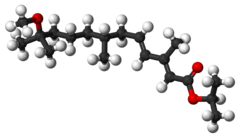Methoprene: Difference between revisions
repair ref |
edit and replace ref by scientific source |
||
| Line 61: | Line 61: | ||
Methoprene is also used as a food additive in cattle feed to prevent fly breeding in the manure. |
Methoprene is also used as a food additive in cattle feed to prevent fly breeding in the manure. |
||
Methoprene may be responsible for killing and stunting the growth of [[lobster]]s |
Methoprene may be responsible for killing and stunting the growth of [[lobster]]s.<ref>{{ cite journal | author = Walker, A. N.; Bush, P.; Puritz, J.; Wilson, T.; Chang, E. S.; Miller, T.; Holloway, K.; Horst, M. N. | title = Bioaccumulation and Metabolic Effects of the Endocrine Disruptor Methoprene in the Lobster, ''Homarus americanus'' | journal = Integrative and Comparative Biology | year = 2005 | volume = 45 | issue = 1 | pages = 118–26 | doi = 10.1093/icb/45.1.118 | url = http://icb.oxfordjournals.org/content/45/1/118.full.pdf }}</ref> Considering the durability of the chemical in the environment (about two days), the lasting effect of the biological activity of the substance in the environment (about one week), it should be further investigated.<ref>{{ cite journal | author = Madder, D. J.; Lockhart, W. L. | title = Studies on the Dissipation of Diflubenzuron and Methoprene from Shallow Prairie Pools | journal = The Canadian Entomologist | year = 1980 | volume = 112 | issue = 2 | pages = 173–7 | doi = 10.4039/Ent112173-2 }}</ref> |
||
==References== |
==References== |
||
Revision as of 22:12, 27 October 2014

| |
| Names | |
|---|---|
| IUPAC name
1-methylethyl (E,E)-11- methoxy-3,7,11-trimethyl- 2,4-dodecadienoate
| |
| Other names
Methoprene, Altosid, Apex, Diacan, Dianex, Kabat, Minex, Pharorid, Precor, ZR-515
| |
| Identifiers | |
3D model (JSmol)
|
|
| ChEBI | |
| ChEMBL | |
| ChemSpider | |
| ECHA InfoCard | 100.049.977 |
| KEGG | |
| MeSH | C093000 |
PubChem CID
|
|
CompTox Dashboard (EPA)
|
|
| |
| |
| Properties | |
| C19H34O3 | |
| Molar mass | 310.48 g/mol |
| Appearance | Liquid |
| Boiling point | 100 °C at 0.05 mmHg |
Except where otherwise noted, data are given for materials in their standard state (at 25 °C [77 °F], 100 kPa).
| |
Methoprene is a juvenile hormone (JH) analog which acts as a growth regulator when used as an insecticide. It is an amber-colored liquid with a faint fruity odor which is essentially nontoxic to humans when ingested or inhaled. It is used in drinking water cisterns to control mosquitoes which spread dengue fever and malaria.[2]
Methoprene does not kill adult insects. Instead, it acts as a growth regulator, mimicking natural juvenile hormone of insects. Juvenile hormone must be absent for a pupa to molt to an adult, so methoprene-treated larvae will be unable to successfully change from pupae to adults. This breaks the biological life cycle of the insect, preventing recurring infestation. Methoprene is used in the production of a number of foods, including meat, milk, mushrooms, peanuts, rice, and cereals. It also has several uses on domestic animals (pets) for controlling fleas. Methoprene is considered a biochemical pesticide because rather than controlling target pests through direct toxicity, methoprene interferes with an insect’s lifecycle and prevents it from reaching maturity or reproducing.[3] Methoprene is used most widely as the mosquito larvicide Altosid, which is an important measure in reduction of the spread of West Nile virus.
Methoprene is also used as a food additive in cattle feed to prevent fly breeding in the manure.
Methoprene may be responsible for killing and stunting the growth of lobsters.[4] Considering the durability of the chemical in the environment (about two days), the lasting effect of the biological activity of the substance in the environment (about one week), it should be further investigated.[5]
References
- ^ Merck Index, 11th Edition, 5906.
- ^ "Methoprene" (PDF). Water Sanitation and Health. World Health Organization. 2008.
- ^ "Insect Growth Regulators: S-Hydroprene (128966), S-Kinoprene (107502), Methoprene (105401), S-Methoprene (105402) Fact Sheet" (PDF). U.S. Environmental Protection Agency Office of Pesticide Programs.
- ^ Walker, A. N.; Bush, P.; Puritz, J.; Wilson, T.; Chang, E. S.; Miller, T.; Holloway, K.; Horst, M. N. (2005). "Bioaccumulation and Metabolic Effects of the Endocrine Disruptor Methoprene in the Lobster, Homarus americanus" (PDF). Integrative and Comparative Biology. 45 (1): 118–26. doi:10.1093/icb/45.1.118.
{{cite journal}}: CS1 maint: multiple names: authors list (link) - ^ Madder, D. J.; Lockhart, W. L. (1980). "Studies on the Dissipation of Diflubenzuron and Methoprene from Shallow Prairie Pools". The Canadian Entomologist. 112 (2): 173–7. doi:10.4039/Ent112173-2.
{{cite journal}}: CS1 maint: multiple names: authors list (link)
External links
- Methoprene Pesticide Fact Sheet - Environmental Protection Agency
- Methoprene Pesticide Information Profile - Extension Toxicology Network
- Pesticide Properties Database record for methoprene
